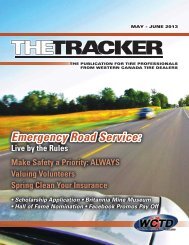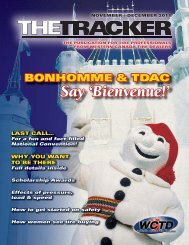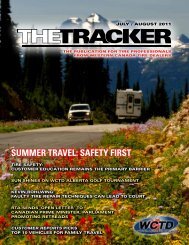Download - Western Canada Tire Dealers
Download - Western Canada Tire Dealers
Download - Western Canada Tire Dealers
You also want an ePaper? Increase the reach of your titles
YUMPU automatically turns print PDFs into web optimized ePapers that Google loves.
MATT’S MATTERSBE (VERY) WARY OF POSSIBLEZIPPER RUPTURESEVERY YEAR IMPROPER HANDLING INJURES OR KILLS TIRE TECHNICIANSBy: Matt White, TIA Director of <strong>Tire</strong> Service1234567One of the biggest dangers that a tire technician faces oncommercial truck tires is what is known as a Zipper Rupture—defi ned as a break in the steel belts on the sidewall due tobeing in an under-inflated and / or overloaded condition.Any tire suspected of operating under-inflated and / oroverloaded must be approached with extreme caution!Permanent damage due to operating a tire under-inflatedand/or overloaded cannot always be detected.Ply cords weakened by under-inflation and / or overloadingmay break on the sidewall, causing an extreme rupture tooccur in the side wall. The instantaneous air loss releaseswith such explosive force that if you are in the trajectory zoneit could cause serious injury or death.If any radial light truck or commercial truck tire upon anair pressure check is found to be 80 percent or less of theoperating pressure it must be immediately deflated. Write thepressure on the sidewall to indicate the tire could potentiallyhave a zipper rupture and must be removed from the vehicle,dismounted from the rim, and that a proper inspection mustbe performed.After removing the tire from the rim, perform the followinginspections: LOOK for punctures and / or other injuries,distortions or undulations, ripples, bulges, plus any cuts,snags or chips that expose any body ply cords or steel wires.FEEL for any soft spots in the sidewall flex area, as well asany distortions or undulations and keep feeling for anythingindicating broken body cords.Any wrinkles or discolourations of the inner lining in thefl ex area on the sidewall is a really good sign of a tire beingoperated under-inflated and / or overloaded.If a tire is found to have any of these conditions it must beimmediately removed from service. If it is sent for retreadingit must be identified, so the retreader can perform the properprocedures in order for it to be returned to service.89If no signs are found then, before it can be put back in service,it must be inflated ONLY using the following procedures:(a) Mount the tire and inflate to 5 psi, outside a properinspected restraining device, with the valve core removed.Inflate the tire using a clip air chuck with a pressure regulatorand a sufficient enough hose not to be in the trajectory area.(b) If no bulges are found, place in a proper restrainingdevice and inflate to 20 psi, with valve core still removed,looking for any wrinkles or bulging. Listen for any poppingor cracking sounds using the remote air device and stayingclear of the trajectory area. Remember it’s the air that doesthe damage!(c) If there are no signs, then continue to inflate tire to 20psi over max inflation pressure or to max pressure of rim. Theninspect for any of the signs of the zipper rupture. If there isno indication, release the air pressure. Then install the valvecore and inflate to operating pressure. I like to let the tire sitfor 5 minutes in the restraining device just for reassurancethat all is okay.Remember: no matter how big of a hurry you are in, NEVERinflate a truck tire outside of a restraining deviceand always use a remote air station to keep you out of thetrajectory zone. And make sure it is capable of releasing airwithout entering the trajectory zone.For complete zipper rupture inspection procedures refer toRMA volume 33 number 3: Inspection Procedures to IdentifyPotential Sidewall Zipper Ruptures in Steel Cord Radial Truck,Bus, and Light Truck <strong>Tire</strong>s.Remember: NEVER inflate a truck tire without theuse of a proper restraining device and a remote airstation. Every year tire technicians are injured or killedbecause this golden rule is broken.Be Safe and always wear your PPE!!The Tracker | January - April 2013 | www.wctd.ca11







